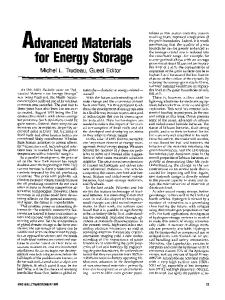Architected materials for advanced electrochemical systems
- PDF / 5,003,516 Bytes
- 7 Pages / 585 x 783 pts Page_size
- 26 Downloads / 336 Views
Background and introduction Electrochemistry, the study of chemistry enabled by the movement of electrons, is the foundation for many chemical processes ranging from biochemical reactions in living organisms to technology-enabled devices in modern energy storage and sensing applications. Figure 1a shows the main components of an electrochemical system—an anode, a cathode, and an electrolyte. Oxidation reactions occur at the anode, reduction reactions occur at the cathode, and the electrolyte allows ions to be transported between the two electrodes while preventing electron transport. Electrons, therefore, are forced to conduct through an external load, whereby one can extract the energy to do work or apply work to drive chemical changes. Material architecture has played a critical role in electrochemical research since the field’s genesis, when A. Volta realized the first battery using thin stacks of copper and zinc discs separated by a cloth-soaked electrolyte (Figure 1a, voltaic pile).1 One can understand the importance of material architecture by considering the constraints of a typical battery electrode2–4 (Figure 1b). Energy is stored in the atomic bonds of the anode and cathode materials, and energy density is increased as more material is packed into the same volume. Electrochemical reactions, however, primarily occur at the interface between the electrodes and the electrolyte (Figure 1b, red text) so that large reaction rates, which increase power
density, require electrodes with high surface area-to-volume ratios. Electrodes, therefore, can be geometrically optimized, typically through miniaturization and added porosity,3,5–7 to have simultaneously high surface areas (power) and high solids volume fractions (energy). Figure 1c shows a Ragone plot that compares the energy and power tradeoffs in different energy-storage technologies. Architected materials enable improvements in both power and energy (green areas) by accommodating chemical changes (reactions often have corresponding volume and materials property changes) and increasing transport of the reactants and products to and from reaction sites. Electrode architectures must be able to accommodate the transport of products and reactants across multiple phases with often varying transport speeds. Reactants and products stored in the solid electrode bulk must diffuse between the bulk and electrode surface (Figure 1b, green), where reactions occur, and be transported from the interface of one electrode to the other (Figure 1b, blue). Additionally, electrons (Figure 1b, black) and ions must be simultaneously transported between electrodes; as many battery materials are poor conductors of one or both, additional conductive components are included to mitigate transport deficiencies. Many material architectures have been realized to overcome these constraints and often combine four or more materials into
James H. Pikul, the University of Pennsylvania, USA; [email protected] Jeffrey W. Long, US Naval Research Laboratory, USA; [email protected] doi:
Data Loading...











